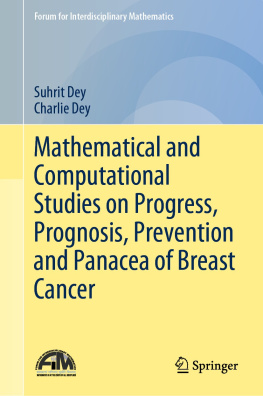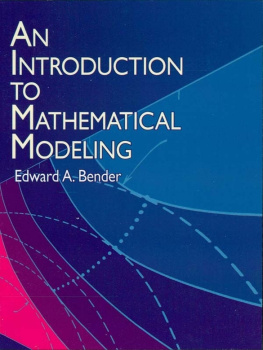Copyright @ 2015 by Thomas L. Saaty
ISBN: 978-1-888603-41-5
Published as an ebook in 2015 by RWS Publications, Pittsburgh
www.rwspublications.com
Preface
In the past decade there has been a surge of interest in mathematical modeling. This is partly due to a demand for relevance of theoretical material in the real world and partly due to an intense search for methods to deal with complex societal problems. Many books have been written on the subject. The original material of this book dates back to the sixties. However, its spirit will probably be here for some time. It is to catalogue a wide variety of models for easy access and mental stimulation. It is the idea of a variety of models, rather than a complete description of how to model, that is the significant feature of this work. No one person has the time or incentive to study in detail every published model. But one can glean useful ideas from short summaries of models in different areas.
Real-life problems are messy, approximate, interconnected, demanding, and time consuming. It is not easy to solve a worthwhile one in a short exercise. Thus one often resorts to simple analogies to train the mind and prepare it for the variety existing in complex reality.
Creativity has been defined on many occasions as a process of selection from a broad combinatorial number of possibilities. This implies that one should obtain a wide exposure in order to become aware of variety and should develop good judgment in order to make a wise selection. Our purpose here is to provide this wide exposure in order to broaden the reader's combinatorial awareness. We give as comprehensive an account of mathematical models as possible in a book of this size. However, we must add that the improvement of judgment requires extensive training and experience; examples alone are insufficient for this purpose.
We have avoided philosophizing about the wherefores and hows and have concentrated our effort on examples of applications from several areas of human endeavor. Our purpose is not to solve but to formulate, since there is a definite need to improve the ability to structure and formulate problems creatively. Solving is an established art in our colleges, universities, and scientific laboratories. Formulation is still a mystery relegated to the not yet well understood process of creativity. We feel that formulation can also be taught successfully at school in spite of the lack of real understanding of its methods and practices. When approached pragmatically, formulation of problems as mathematical models must be done frequently, in a variety of ways, daringly, and without fear of making mistakes. In time, the modeler learns to improve his style and to increase his ability to select the type of model he needs. The basic principle is that exposure and practice have no better substitute in the business of modeling. This book is a step in the direction of providing examples. It is a synthesis of a variety of formulations which cuts across the broad terrain of mathematical tools.
In the past quarter of a century, operations research, systems analysis, management science, and other related fields have brought the power of scientific analysis into a variety of military, governmental, industrial, and management problems. These are problems whose underlying motivation is the decision process. Most of the successes have come from applications made to processes treated as physical systems, be they economic, dietary, product mix, or whatever.
In the physical sciences it has generally been possible to introduce measurement into a problem, thus enabling one to quantify and to model. From these models, theories were developed to explain the underlying causal relationships. As the complexity and variety of problems increased, computer simulation became a popular device for experimentation with solutions. However, this type of solution does not usually provide an adequate understanding of the problem that can be communicated easily. We remain hopeful that new mathematical and scientific theories (such as the analytic hierarchy process on which we have been working) will arise to help us in these new behavioral areas in which human factors are prominent.
We feel strongly that wide exposure to, and continued awareness of, the diversity of mathematical methods available for application to problems can help increase the problem-solver's range of choice among methods to formulate problems. The art of problem solving has been explored by a number of people, the foremost among whom is George Polya, whose How to Solve It is universally known and has been translated into many languages. In his writings, Polya confines his attention to solving mathematical problems with mathematical tools. Our purpose is much broader as we attempt to reach the limits of the natural and social sciences. We should point out, however, that many of the models in the biological and social sciences are initial attempts to develop explanatory models and are not necessarily valid.
The book was conceived and developed in several drafts over the years by the first author. The earlier drafts have been used in courses at the University of Pennsylvania and in the National Science Foundation Chautauqua-Type Short Courses for College Teachers which he gave for the American Association for the Advancement of Science. The collection has been constantly updated and reduced in size so as to provide a reasonable-length book. In this last draft, a short section of models based on the theory of analytic hierarchies and priorities, developed by the first author, is also included. Some of the earlier models are still the best ones. Other models are in such a state of constant change that it was best to stick with one version of them; still we believe that this work represents the state of the art in modeling.
The material can be used for teaching purposes in a semester course on modeling or as supplementary reading for a two-semester course. It can also serve as a useful reference book for practitioners in the natural sciences and in operations research and management science.
The asterisk (*) indicates those sections that may be difficult or require special knowledge but may be skipped without affecting the understanding of the other material.
We hope that this book will be a learning tool for teachers as well as for students; we also hope to learn ourselves from those who use the book. To this end we ask that teachers who have discovered good exercises they would like to see in the book send them to us to be included in the next revision with full acknowledgments to them. We also welcome all comments and suggestions. Since modeling is an ever-growing field, we wish to encourage the idea of learning from each other to maintain the forward thrust of the field.







